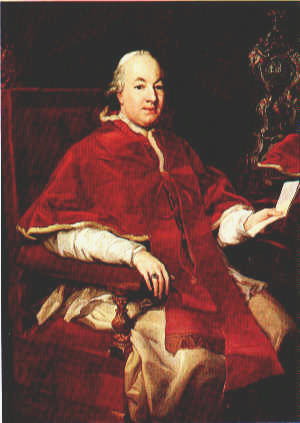 "As handsome as he is holy," thus the Romans described Gianangelo Braschi,
who as Pius VI succeeded Clement XIV. Gianangelo Braschi was born December
25, 1717, at Cesena of noble parents. After studies with the Jesuits, the
bright young man took his degree in law when only seventeen. Braschi caught
the eye of Benedict XIV, who offered him a canonry in St. Peter's, but the
handsome lawyer was engaged to be married. At last he decided to become a
priest; his fiancée entered a convent. Braschi became papal treasurer, and
in 1773 a cardinal. Not yet sixty and full of vigor, Pius VI was to need
all his reserves of holiness and strength to face what was coming.
"As handsome as he is holy," thus the Romans described Gianangelo Braschi,
who as Pius VI succeeded Clement XIV. Gianangelo Braschi was born December
25, 1717, at Cesena of noble parents. After studies with the Jesuits, the
bright young man took his degree in law when only seventeen. Braschi caught
the eye of Benedict XIV, who offered him a canonry in St. Peter's, but the
handsome lawyer was engaged to be married. At last he decided to become a
priest; his fiancée entered a convent. Braschi became papal treasurer, and
in 1773 a cardinal. Not yet sixty and full of vigor, Pius VI was to need
all his reserves of holiness and strength to face what was coming.
Pius found the Jesuit problem still haunting the Vatican. He released some
Jesuits imprisoned by Clement, but friendly as he was, he dared not do
more. When he showed an inclination to allow the Society of Jesus to remain
alive in Russia, the Bourbons stormed at him so fiercely that he had to
insist on breaking up this last Jesuit province. Catherine of Russia,
however, refused to allow the brief of suppression to be published in her
dominions, and since Clement had so arranged matters that the suppression
brief would become law in a diocese only when the bishop published it, the
Jesuits lived on in Russia. In 1780 Pius VI, by word of mouth, approved of
their existence.
The Jesuit problem was the least of the Pope's worries. Emperor Joseph II,
flailing about in a frenzy of misdirected zeal, was limiting papal power,
suppressing monasteries, and changing church regulations in a manner which
led sardonic Frederick II to call him "my brother the sacristan." However
amusing to old Fritz, Joseph's vagaries were more than an annoyance to
Pius. He actually made the long trip to Vienna to try to talk sense into
the imperial meddler, but in vain. Joseph's brother, Leopold, Grand Duke of
Tuscany, was just as bad, and one of his bishops, Ricci of Pistoia, held a
synod in 1786 which passed some outrageous decrees. Pius condemned these in
1794. The ecclesiastical electors--the prince-bishops of Mayence, Treves,
and Cologne--got into the act in 1786 by issuing a Febronian manifesto
known as the Punctuation of Ems. Febronianism was the doctrine taught by
Von Hontheim (who wrote under the pen name Febronius) which claimed that
the pope was not superior to all bishops and that Catholic kings should
reduce the papal power.
The king of Naples saw to it that Bourbons contributed to the Pope's
misery, but all these troubles faded in the intense glare of the French
Revolution.
Pius grew increasingly alarmed as the revolutionists multiplied anti-
Catholic measures. The confiscation of Church property, the suppression of
papal taxes, the patient Pope let go by, but he secretly protested against
the suppression of religious orders, and he had to speak out when the
little bunglers of the Constituent Assembly tried to drive France into
schism with the Civil Constitution of the Clergy. Pius saw the Church in
France driven underground as blood-drunk Jacobins drove priests and nuns to
the knife. Soon the Revolution flowed over the Alps and Napoleon forced the
Pope to accept the harsh Treaty of Tolentino in 1797. But the Directory,
more cruel than Napoleon, soon took over Rome and made the old Pope a
prisoner. Dragged to France, Pius was greeted by the people with
affectionate enthusiasm. His health gave way at Valence, and a prisoner and
an exile, Pius VI died August 22, 1799. His last words were: "Lord forgive
them."
Excerpted from "Popes
Through the Ages" by Joseph Brusher, S.J.

